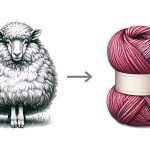Are you curious about whether fleece fabric is actually wool? In this article, we’ll delve into the origins of fleece fabric, its composition, and how it compares to wool.
We’ll also explore the manufacturing process, properties, and sustainability of fleece. Debunking common myths about fleece and wool, we aim to help you make an informed choice between the two.
So, let’s settle the debate once and for all: is fleece fabric a wool?
Table of Contents
The Origins of Fleece Fabric
Fleece fabric isn’t actually made from wool, but rather synthetic materials. Despite its name, fleece does not come from sheep or any other animal. It was first developed in the 1970s as a synthetic alternative to natural wool. The origins of fleece can be traced back to the need for a lightweight and warm fabric that could be used in outdoor clothing.
The sustainability of fleece has been a topic of debate in recent years. While it is true that fleece is made from synthetic materials, which are derived from non-renewable resources, it also has some environmental benefits. Fleece is highly durable and long-lasting, which means that it can be used for a longer period of time compared to other fabrics. This reduces the need for frequent replacements and ultimately reduces waste. Additionally, fleece is often made from recycled materials, such as plastic bottles, which helps to reduce the overall environmental impact.
Understanding the Composition of Fleece
You’ll be surprised to learn that this soft and cozy material is actually made from synthetic fibers. Fleece fabric is a popular choice for its warmth and comfort, but many people are unaware of its true composition. Understanding the fleece composition and properties can help you make informed decisions when it comes to purchasing and caring for fleece garments.
Here are some key points to consider:
- Fleece is typically made from polyester, a type of synthetic fiber. This means that it is not derived from natural sources like wool.
- Polyester fleece is created by melting down plastic pellets and then spinning them into fibers. These fibers are then woven or knitted to create the fleece fabric.
- Fleece is known for its excellent insulating properties, making it a great choice for cold weather clothing.
- Unlike wool, fleece is lightweight and dries quickly, making it ideal for outdoor activities and sports.
Comparing Fleece to Wool: Similarities and Differences
Polyester, a synthetic fiber commonly used in fleece, differs from wool in terms of its composition and properties. While wool is a natural fiber derived from sheep, polyester is a man-made material created from petroleum products. This distinction in composition leads to several differences in the properties of fleece compared to wool.
One of the main differences between fleece and wool is the warmth factor. Wool is known for its excellent insulation properties, as it can retain heat even when wet. On the other hand, polyester fleece is not as effective in retaining heat when damp. However, fleece is generally lighter in weight than wool, making it a popular choice for outdoor activities and layering.
Another important aspect to consider is the eco-friendly factor. Wool is a sustainable and renewable resource, as it can be shorn from sheep without causing harm to the animal. Additionally, wool is biodegradable and does not release harmful chemicals when decomposing. Polyester, on the other hand, is derived from non-renewable resources and takes a long time to break down in the environment.
To summarize the differences between fleece and wool:
| Fleece | Wool |
|---|---|
| Synthetic fiber made from polyester | Natural fiber from sheep |
| Less effective in retaining heat when damp | Excellent insulation properties, even when wet |
| Lighter in weight | Heavier |
| Derived from non-renewable resources | Sustainable and renewable |
| Takes a long time to decompose | Biodegradable |
When choosing between fleece and wool, consider your specific needs and values. If warmth and sustainability are important to you, wool may be the better option. However, if lightweight and quick-drying properties are a priority, fleece could be the right choice.
The Manufacturing Process of Fleece Fabric
When making fleece, the fibers are spun together to create a soft and insulating material. Fleece fabric is manufactured through a multi-step process. First, the raw materials, usually polyester or recycled plastic bottles, are collected. These materials are then sorted, cleaned, and melted down into a liquid form.
Next, the liquid is extruded through tiny holes to create long filaments. These filaments are then cooled and solidified to form fibers. The fibers are then stretched, twisted, and spun together to create yarn. This yarn is then woven or knitted into fabric using specialized machines. Once the fabric is made, it undergoes a finishing process to enhance its softness and durability.
The manufacturing process of fleece fabric has both positive and negative environmental impacts. On the positive side, fleece fabric can be made from recycled materials, reducing the need for new resources. Additionally, the production of fleece fabric requires less water and energy compared to traditional wool manufacturing. However, the use of synthetic materials like polyester in fleece fabric contributes to the release of microplastics into the environment.
These microplastics can pollute waterways and harm marine life. Therefore, it is important for manufacturers to implement proper waste management systems and consider more sustainable alternatives in the production of fleece fabric to minimize its environmental impact.
Exploring the Properties of Fleece
Exploring the properties of fleece can provide insight into its softness, insulation, and durability.
Fleece is known for its exceptional softness, making it a popular choice for clothing and blankets. Its fibers are finer and shorter compared to traditional wool, which contributes to its cozy texture.
The insulating properties of fleece are another key benefit. It has a high loft that traps air between its fibers, creating a warm and comfortable barrier against cold temperatures. This makes fleece an ideal fabric for outdoor activities and winter wear.
Additionally, fleece is highly durable. Its synthetic composition allows it to withstand repeated washing and wear without losing its shape or becoming damaged. It is also resistant to pilling, ensuring that it maintains its appearance and feel over time.
The properties of fleece make it a versatile and practical fabric choice for various applications. Whether you’re looking for softness, insulation, or durability, fleece delivers on all fronts.
Is Fleece a Sustainable Alternative to Wool?
In this discussion, let’s explore the question of whether fleece can be considered a sustainable alternative to wool.
We will compare the environmental impacts of both materials and examine their long-term sustainability potential.
Fleece Vs. Wool
Fleece fabric is often preferred over wool for its softness and ease of care. When it comes to performance, fleece has the upper hand. It is highly breathable, wicking away moisture from your body and keeping you dry during physical activities.
Wool, on the other hand, can retain moisture and become heavy and uncomfortable. In terms of comfort, fleece wins again. It is lightweight and has a cozy, soft feel against the skin. Wool, although warm, can sometimes feel scratchy and irritating.
Additionally, fleece is machine washable and dries quickly, making it low maintenance compared to wool, which requires special care. Overall, if you prioritize performance and comfort, fleece is the way to go.
Environmental Impact Comparison
When considering the environmental impact, it’s important to note that fleece is made from synthetic materials, while wool is a natural fiber. Here’s a comparison of their environmental impact:
-
Fleece:
-
Made from synthetic materials like polyester, which is derived from non-renewable resources like petroleum.
-
Production of fleece involves the use of chemicals and energy-intensive processes, contributing to air and water pollution.
-
Fleece fabrics shed microplastics when washed, polluting water bodies and harming marine life.
-
Wool:
-
Derived from sheep, a renewable resource, making it more sustainable in the long term.
-
Wool production requires less energy and chemicals compared to fleece.
-
Wool is biodegradable and can be composted at the end of its lifecycle.
Considering the environmental impact and long-term sustainability potential, wool is a more eco-friendly choice compared to fleece.
Long-Term Sustainability Potential
Derived from a renewable resource, wool’s long-term sustainability potential makes it an eco-friendly choice. Wool is a natural fiber that comes from sheep, which can be shorn annually without causing harm. This renewable resource reduces the need for synthetic fibers that contribute to pollution and waste. Additionally, wool has longevity benefits, as it is durable and resistant to wear and tear. This means that woolen garments, such as sweaters and blankets, can last for many years, reducing the need for frequent replacements. From an ethical standpoint, wool production can have positive implications for animal welfare when done responsibly. By choosing wool products, you are not only supporting sustainable practices but also contributing to the well-being of sheep.
Consider the following table to understand the longevity benefits and ethical implications of wool:
| Longevity Benefits | Ethical Implications |
|---|---|
| Durable | Responsible sourcing |
| Resistant to wear and tear | Animal welfare |
| Long-lasting | Sustainable practices |
Debunking Common Myths About Fleece and Wool
One common myth about fleece and wool is that they are the same material. However, this is not accurate. Fleece fabric is actually made from synthetic fibers, typically derived from polyester. On the other hand, wool is a natural fiber that comes from sheep or other animals like goats or alpacas.
Fleece fabric has gained popularity over the years due to its numerous benefits. First and foremost, fleece is known for its exceptional warmth and insulation properties. It is incredibly soft and lightweight, making it a comfortable choice for various outdoor activities. Fleece is also highly breathable, allowing moisture to escape while keeping you dry. Additionally, it is quick-drying and easy to care for, as it resists shrinking and wrinkling.
Despite these advantages, there are some misconceptions about fleece that need debunking. One common misconception is that fleece is not environmentally friendly. While it is true that fleece is made from synthetic fibers, advances in technology have led to the creation of recycled fleece, which reduces its impact on the environment. Moreover, fleece is often used as an alternative to wool, which is a more resource-intensive material.
Making an Informed Choice: Fleece or Wool?
When it comes to choosing between fleece and wool, there are several key factors to consider.
First, you’ll want to compare their warmth capabilities.
Next, it’s important to assess the environmental impact of each option.
Finally, durability and maintenance should be taken into consideration.
Fleece Vs. Wool Warmth
Did you know that fleece fabric is actually warmer than wool? When it comes to warmth, fleece has some advantages over wool. Here’s why:
-
Thermal properties: Fleece is made from synthetic materials like polyester, which have excellent insulation properties. It traps warm air close to your body, keeping you cozy in cold weather. Wool, on the other hand, is a natural fiber that provides insulation but may not be as effective as fleece in extreme cold conditions.
-
Moisture wicking performance: Fleece has superior moisture-wicking abilities compared to wool. It pulls sweat away from your skin, keeping you dry and comfortable during physical activities. Wool, while also capable of absorbing moisture, may become heavy and less breathable when wet.
-
Weight and bulk: Fleece is generally lighter and less bulky than wool, making it more convenient for layering or packing. It offers warmth without adding unnecessary weight or restricting movement.
-
Durability and maintenance: Fleece is easy to care for, as it is machine-washable and dries quickly. It is less prone to shrinking or matting compared to wool, which may require more careful handling.
Environmental Impact Comparison
The environmental impact of fleece and wool differs significantly.
When comparing fleece to cotton, fleece has a lower environmental impact. Fleece is made from synthetic materials like polyester, which is derived from petroleum. Producing polyester requires less water and energy compared to growing and processing cotton. Fleece also has the advantage of being highly durable, meaning it can last longer and reduce the need for frequent replacements.
On the other hand, wool production has its own environmental challenges. Sheep farming requires vast amounts of land, water, and food for the animals. Additionally, the methane produced by sheep contributes to greenhouse gas emissions. However, wool is a renewable and biodegradable material, making it a more sustainable choice in the long run.
Durability and Maintenance
Now that you understand the environmental impact of fleece fabric, let’s explore its durability and maintenance. Here are the pros and cons you need to consider:
Durability:
- Pros: Fleece fabric is known for its durability and ability to withstand wear and tear. It is resistant to pilling and retains its shape even after multiple washes.
- Cons: However, over time, fleece fabric can start to lose its softness and may develop small holes or snags.
Maintenance:
- Pros: Fleece fabric is easy to care for. It is machine washable and dries quickly. It also does not require ironing.
- Cons: On the downside, fleece fabric tends to attract and hold onto lint, pet hair, and other particles. Regular washing and lint rolling are necessary to keep it clean.
Consider these factors when deciding whether fleece fabric is the right choice for you, taking into account its durability and maintenance requirements.
Conclusion
In conclusion, when it comes to choosing between fleece and wool, it’s important to consider their origins, composition, properties, and sustainability.
Fleece fabric, although not made from wool, offers similar warmth and softness. It is a popular and affordable alternative.
However, wool remains a natural and renewable fiber with excellent insulation and moisture-wicking properties.
Both options have their benefits, so make an informed choice based on your preferences and needs.
- Leading Brands in Eco-Friendly Fashion - July 18, 2024
- The Comeback of Vintage Fabrics - July 18, 2024
- Sustainable Fashion Trends to Know - July 18, 2024





